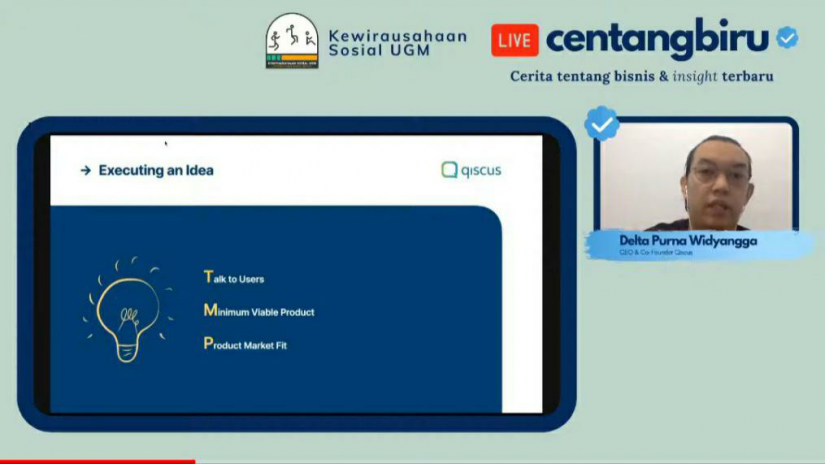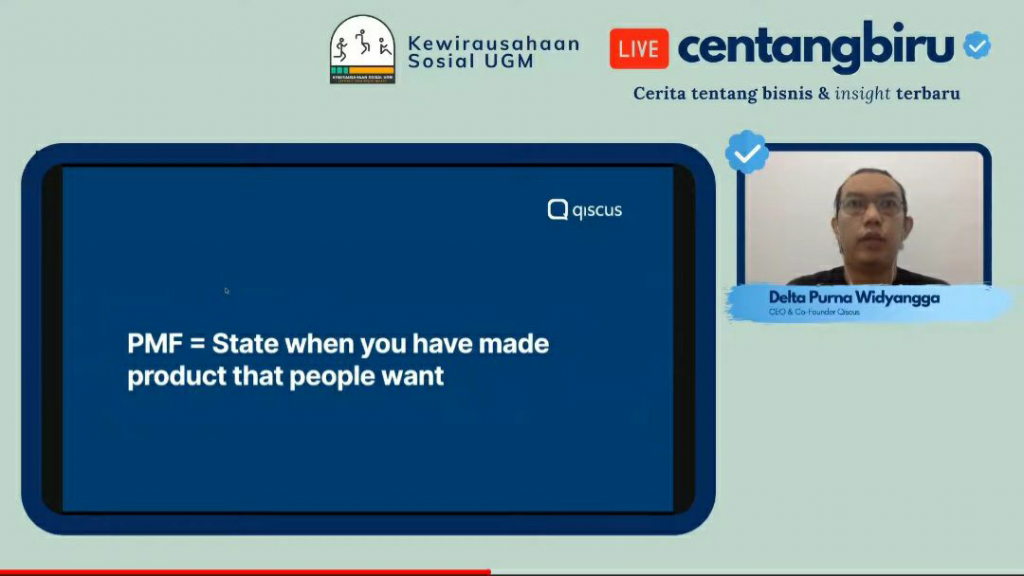
Yogyakarta, 4 July 2020—Upon succeeding in organizing various entrepreneurship classes, Kewirausahaan Sosial UGM/UGM Social Entrepreneurship Program came up with a new series of classes titled Centang Biru–Cerita tentang Bisnis dan Insight Terbaru/Stories of Businesses and Fresh Insights. Similar with the previous Series of Social Entrepreneurship Courses, Centang Biru was also aired on Kewirausahaan Sosial UGM’s Youtube channel. In its first episode, Centang Biru invited Delta Purna Widyangga, CEO and co-founder of QISCUS, to speak under the theme of “From Ideas to Execution”.
Delta briefly introduced himself and his start-up, QISCUS, before delivering his points. He began the discussion by throwing a question to the audience, “what is the most important quality of a start-up founder?”. The answer varies, ranging from characteristics of leadership to technical skills. Responding to the answers, Delta explained that generally, a start-up founder needs to know how to take off (with an idea) and survive.
Taking off consists of several components. Besides an idea, the existence of a product and team, good execution, and luck are also necessary. In this episode, Delta elaborated on points of execution, consisting of talking to users, minimum viable product, and product market fit.

Talking to users, Delta added, will always be an important point in developing a start-up company, not only in the beginning. Founders need to identify their users: whether friends, colleagues, or themselves. As a starter, a limited number of users should not be a problem. A lot can be observed from five to ten users. Also, founders should not forget to appreciate these users. To learn talking to users better, Delta recommended reading The Mom Test. The book provided instances of specific, but not leading, types of questions fit to be used for talking to users.
Another necessary component is releasing minimum viable product/MVP. The key to this component is crafting a product that is fit for daily use. As MVPs are pretty simple–or even, not in a solid form of a product–everything can be done manually, as long as the MVP serves its original function. One stage in releasing MVP is prototyping. Using frameworks like design thinking and design sprint, this stage is useful in assisting founders before releasing a product, both in early stages and in following revisions. Prototyping helps founders observe users’ experience and put their solutions to certain issues to test. That said, releasing MVP starts with receiving inputs (by talking to users), improving the product, and releasing the revised product.
Upon releasing MVP, founders have to consider product market fit. Product market fit is a condition when start-ups have succeeded in creating products that the market desires. To reach this point, start-ups need to discover whether their users actually use their product. To find out, start-ups need certain measurements (that might vary from one start-up to another). In an effort to give a better understanding, Delta added several instances of simple measurements from well-known start-ups, including QISCUS’. The measurement needs to be done weekly after releasing MVP, using one primary matrix (i.e. user activities, rise in income) and three to five secondary matrices as control variables. In a situation where users are limited in number, surveying product market fit might be done through talking to users. Delta suggested that founders need to avoid talking about growth before reaching product market fit.
The discussion continued with a question and answer session through Google Meet. Delta wrapped the session up with a closing statement. “The points that I delivered earlier were what I personally consider important. Hopefully, they will be useful in the future,” Delta concluded. Ending his discussion at 11.30 AM, Delta recommended a few books and shows that might inspire building one’s own start-up. For those who would like to rewatch the first episode of Centang Biru, both in the form of short clips and full version, can go to Kewirausahaan Sosial UGM’s Youtube channel.
